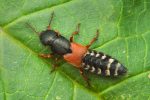HOW DO YOU HANDLE A CHEMICAL WEAPONS EXPOSURE
WHAT IS A CHEMICAL WEAPONS ?
A chemical used to cause intentional death or harm through its toxic properties.
Munitions, devices and other equipment specifically designed to weaponize toxic chemicals also
fall under the definition of chemi.cal weapons.
This definition includes toxic chemicals and their precursors.
- Chemical weapons are chemical agents, whether gaseous, liquid, or solid, that are employed because of their direct toxic effects on humans, animals, and plants. They inflict damage when inhaled, absorbed through the skin, or ingested in food or drink.
- Chemical agents become weapons when they are placed into artillery shells, land mines, aerial bombs, missile warheads, mortar shells, grenades, spray tanks, or any other means of delivering the agents to designated targets.
History:
Chemical weapons were first used in World War I (1914–18), during which gas warfare inflicted more than one million of the casualties suffered by combatants in that conflict and killed an estimated 90,000.
Chemical arms have been employed numerous times, most notably in the Iran-Iraq War (1980–88) and the Syrian Civil War.
The United States and the Soviet Union, during their decades of confrontation in the Cold War (1945–91), built up enormous stockpiles of chemical weapons.
World War I (first generation), World War II (second generation), and the Cold War (third generation).
Fourth-Generation Chemical Warfare Agents :
A new category of chemical warfare nerve agents was reportedly developed in the former Soviet Union in the 1970s to 1990s. This class of agent was developed to be highly toxic, untraceable, and undetectable. The so-called fourth generation agents (FGAs), also known as Novichoks or non-traditional agents, are low volatility nerve agents that evaporate even less readily than VX. FGAs are at least as potent as VX; it takes a lower, or a similar, dose of an FGA compared to VX to cause adverse health effects or death.
Qualities Required for A CW agent :
- High Toxicity
- Imperceptibility to senses
- Rapidity of action after dissemination
- Persistency
4 TYPES of chemical agents :
1. Choking agents
2. Blister agents
3. Blood agents
4. Nerve agents
Choking agents irritate the nose, throat, and lungs when inhaled
Chlorine (Cl), Chloropicrin (PS), Diphosgene (DP), and Phosgene (CG).
Blister agents affect the eyes, respiratory tract, and skin
Sulfur Mustard (H, HD), Nitrogen Mustard (HN), Lewisite (L), and
Phosgene Oxime (CX).
Blood agents inhibit the ability of cells to use oxygen
Hydrogen Cyanide (AC), Cyanogen Chloride (CK), and Arsine (SA).
Nerve agents block the Acetylcholinesterase (AChE) enzyme in the nervous system,
which causes hyper-stimulation of muscles.
Tabun (GA), Sarin (GB), Soman (GD), Cyclosarin (GF), and venomous
agent X (VX).
Route of Entry into the body: 1. Inhalation ( Respiratory tract)
2. Contact ( Skin)
3. Ingestion ( Digestive tract)
4. Injection ( Blood stream)
Transmission/Delivery:
Possible delivery methods for chemical weapons that could expose people in enclosed or crowded spaces include:
- heating, ventilation, and air-conditioning (HVAC) systems of a building;
- misting, aerosolising devices, sprayers, or improvised chemical dispersal devices;
- passive release, such as an open container; chemically enhanced improvised explosive devices intended to disperse a chemical agent;
- introduction of chemical weapons/toxins into food and beverages;
- simple manual processes, including splash attacks.
Health effects :
- eye irritation, visual changes, vomiting and diarrhoea;
- coughing, breathing difficulties and respiratory irregularities;
- muscle weakness, paralysis and seizures;
- skin redness, irritation and burns;
- collapse, loss of consciousness, or death.
Management:
Defense against chemical weapons
Masks, protective overgarments, special gloves, and boots are required.
The first and most important line of defense against chemical agents is the individual protection provided by gas masks and protective clothing and the collective protection of combat vehicles and mobile or fixed shelter.
Medical treatment
- Many people will require medical treatment for physical injuries as well as mental distress.
- Some people may have incurred a physical injury that has been masked by adrenaline during the attack, and injuries caused by chemical exposure may not be immediately apparent.
- Working with the ambulance service, ensure that all personnel and members of the public are checked, recorded, and given medical treatment where needed.
Grief and trauma counselling
- psychological impact of such a violent event should not be underestimated.
- Everyone reacts differently.
- Consider facilitating grief and trauma counselling for all personnel, irrespective of whether they were present during the attack.
Author: DR. NSTDA, C4A TEAM
Reference : CHEMICAL WEAPONS GUIDELINES FOR CROWDED PLACES
(Commonwealth of Australia 2023, https://www.creativecommons.org )




Good Morning…
Love you all
Morning all 💌
Thanks for the informative.
Thanks for the informative.
. ရေလိုကြည်လင် တို့မေတ္တာတရား..
ကြင်နာသူအားပေးဆပ်ရင်း….
Thanks <3
The effects and consequences of chemical weapons are very tragic and grievous. It should not be invented and used.
Btw song plz admins…
Thanks for sharing ❤️
Thanks for your sharing valuable knowledge Dr & admins. Be safe and healthy 💕🙏
Why do they make such terrible weapons?🤔They should not be produced because they are harmful to the human race.🥺😔
Good morning all guys ❣️
It’s very scary and full of bad effects. Thank you to the admin and the writer, Nestor.
Chemical weapons cause mass causality including innocent people such as children…it should not be used at all.
Chemical weapons, biological weapons and nuclear weapons should never be used 😔 Better people have never invented those things 😞
The effects of Chemical weapons are very devastating… thanks for sharing knowledge!
Thank for sharing.